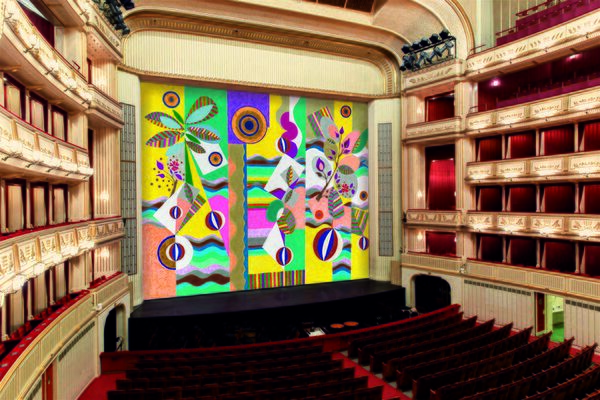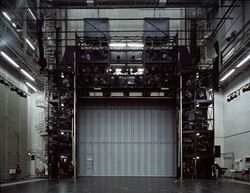The safety curtain is a fire safety device used in large proscenium theatres. It can be lowered to separate the stage house from the auditorium in order to ensure a safe escape of the audience, in the event of fire.
The safety curtain (or fire curtain in America, Q3626) is usually a heavy fibreglass or iron curtain located immediately behind the proscenium arch, sometimes referred to as the ‘iron’, regardless of the construction material.
Fires in theatres occurred frequently in the 19th century due to the use of gas lighting or open flames. In addition, the protection and extinguishing measures of the time were inadequate and often inoperable. In some theatres lightweight protective curtains were employed (so-called wire courtines made of iron wire mesh, first mentioned in Lyon, 1787), which were used like a normal fabric curtain. In 1794 the Theatre Royal, Drury Lane in London (Q7851) became the first theatre to install an iron safety curtain.
Following large fires in the last third of the 19th century, the unity of auditorium and stage was recognised as a weak point, leading to the introduction of safety curtains on a wider scale. In Austria, the iron curtain had been recommended by the fire brigade since at least 1864, and following the Ringtheater fire in Vienna in 1881, it was required by law (Q696). The Asphaleia Society, founded after the accident, made it its task to develop a fire-safe model theatre and mentions a ‘metal curtain’ in its documentation (Q19107). In Germany, the protective curtain also became compulsory from 1889 after several theatre fires, while the fire at the Theatre Royal, Exeter (Q9291) in 1887 – the worst in British history – was influential in the introduction of safety precautions for public buildings.
The introduction of the iron curtain in the theatre marked a turning point in theatre construction and significantly changed the demands on stage technology, as the curtain had to fit out of view above the stage in one piece. The large superstructures above the theatre roofs now housed the iron curtain in addition to the mechanical equipment for the scenery and lighting.
The curtain is extremely heavy and therefore requires its own dedicated operating mechanisms. In an emergency, the stage manager can usually pull a lever backstage which will cause the curtain to lower rapidly into position. In the UK, it is a requirement that a safety curtain must be fully down within the proscenium opening within 30 seconds of being released. A mains-independent warning signal must be audible during travel. Manual release must be possible in at least two places. The fire curtain may contain a door opening, and it must also withstand a pressure difference of 450 Pa in both directions.
In the event of a fire, the use of smoke ventilators above the stage and the fire curtain means that the stage area effectively functions as a chimney. The heated air rises and leaves through the smoke vents, and this puts the building into negative pressure, which in turn draws fresh air in through any open exit doors. Patrons waiting to exit will have fresh breathing air until the exit doors close. The exit doors which open out will be drawn closed tightly by this draft once they are no longer held open by evacuees. Once the doors are closed, the fire loses its oxygen source.
The line of the fire curtain must be kept clear of scenery and no cables may be laid across the ‘iron line’. The water spray extinguishing system required for large stages must also be capable of cooling the protective curtain in order to increase its service life in the event of fire. The safety curtain must be checked for proper function by raising and lowering it every performance day – in the UK, it must be lowered and raised in the presence of the audience, usually during the interval. It must also be inspected regularly by a qualified person.
Iron curtains can also be used for artistic purposes. At the Vienna State Opera, for example, a series of exhibitions conceived by the Vienna Museum has transformed the fire curtain into a temporary exhibition space for contemporary art since 1998. For each season, the curtain is designed by a different artist. In the National Theatre, London’s Lyttelton auditorium the safety curtain divides into two, one half rising up, and the other half lowering into the floor. It was used to great dramatic effect in the opening sequence of the 1992 production of ‘An Inspector Calls’.
The fire curtain at the Theatre Royal, Drury Lane in London is painted with a scene of iron gates, trees and sky, and features a quotation from Shakespeare’s Hamlet: ‘for thine especial safety’. Originating in the age of flame-based lighting, the fire curtain not only protects audiences in the event of fire, it also provides reassurance that their safety is guaranteed.


